1998 GMC SIERRA tow
[x] Cancel search: towPage 345 of 452
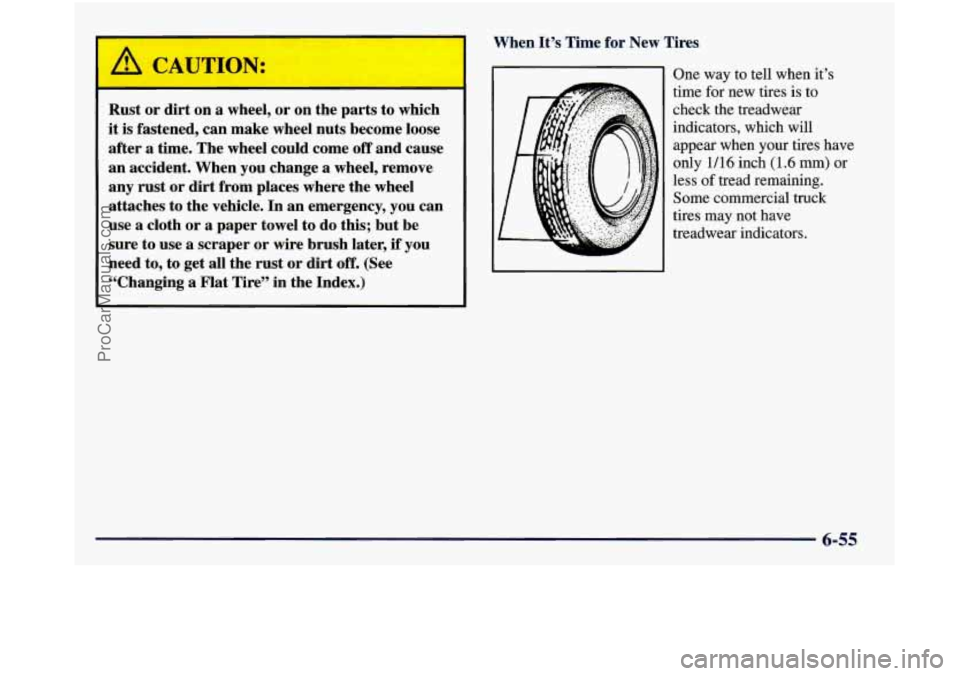
A CAUTION:
Rust or dirt on a wheel, or on the parts to which
it is fastened, can make wheel nuts become loose
after a time. The wheel could come
off and cause
an accident. When you change
a wheel, remove
any rust
or dirt from places where the wheel
attaches to the vehicle. In an emergency, you can
use a cloth or a paper towel to do this; but be
sure to use a scraper or
wire brush later, if you
need to, to get all the rust
or dirt off. (See
“Changing
a Flat Tire” in the Index.)
1 When It’s Time for New Tires
One way to tell when it’s
time for new tires is to
check the treadwear
indicators, which will
appear when your tires have
only
1/16 inch (1.6 mm) or
less of tread remaining.
Some commercial truck
tires may not have
treadwear indicators.
6-55
ProCarManuals.com
Page 352 of 452
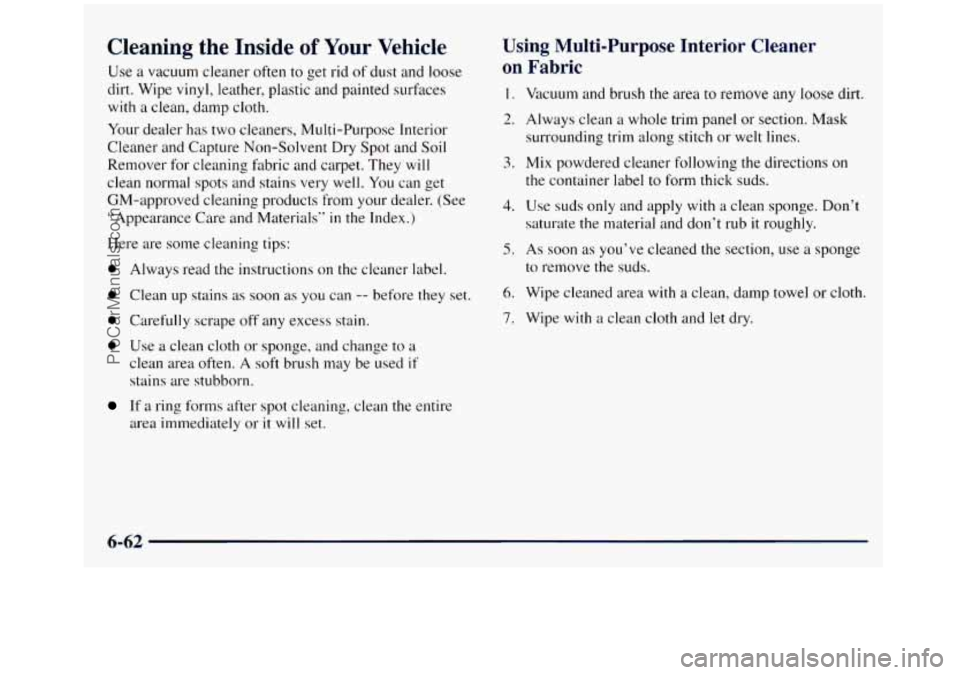
Cleaning the Inside of Your Vehicle
Use a vacuum cleaner often to get rid of dust and loose
dirt. Wipe
vinyl, leather, plastic and painted surfaces
with a clean, damp cloth.
Your dealer has two cleaners, Multi-Purpose Interior
Cleaner and Capture Non-Solvent Dry Spot and Soil
Remover for cleaning fabric and carpet. They
will
clean normal spots and stains very well. You can get
GM-approved cleaning products from your dealer. (See
“Appearance Care and Materials‘‘
in the Index.)
Here are some cleaning tips:
Always read the instructions on the cleaner label.
Clean up stains as soon
as you can -- before they set.
Carefully scrape
off any excess stain.
Use a clean cloth or sponge, and change to a
clean area often.
A soft brush may be used if
stains are stubborn.
If a ring forms after spot cleaning, clean the entire
area immediately
or it will set.
Using Multi-Purpose Interior Cleaner
on Fabric
1.
2.
3.
4.
5.
6.
7.
Vacuum and brush the area to remove any loose dirt.
Always clean a whole trim panel or section.
Mask
surrounding trim along stitch or welt lines.
Mix powdered cleaner following the directions on
the container label to form thick suds.
Use suds only and apply with a clean sponge. Don’t
saturate the material and don’t rub
it roughly.
As soon as you’ve cleaned the section, use a sponge
to remove the suds.
Wipe cleaned area with
a clean, damp towel or cloth.
Wipe with a clean cloth and let dry.
6-62
ProCarManuals.com
Page 356 of 452
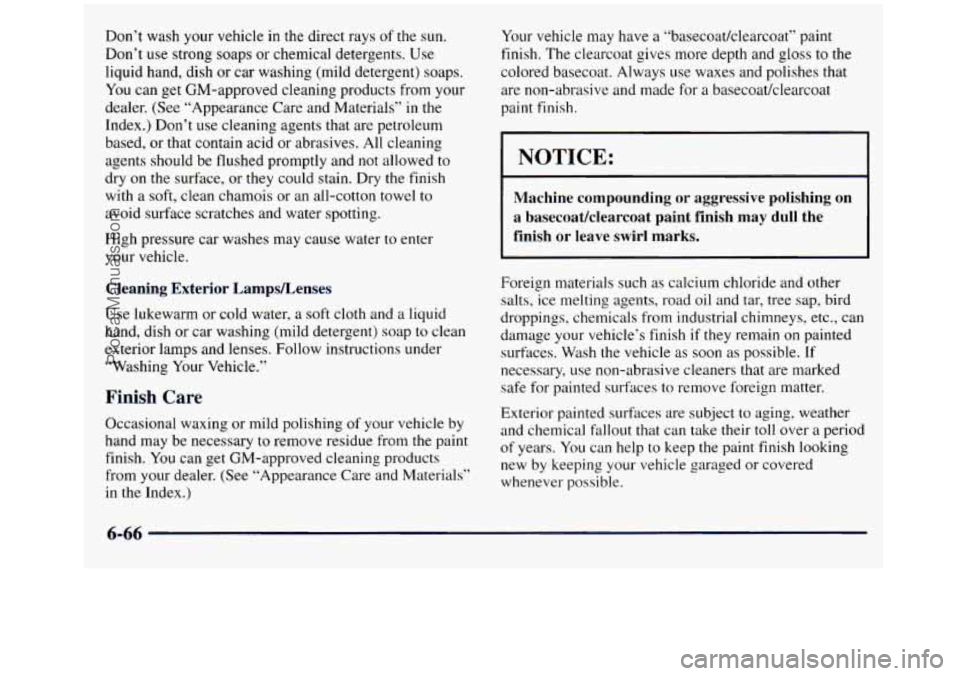
Don’t wash your vehicle in the direct rays of the sun.
Don’t use strong soaps
or chemical detergents. Use
liquid hand, dish or car washing (mild detergent) soaps.
You can get GM-approved cleaning products from your
dealer. (See “Appearance Care and Materials” in
the
Index.) Don’t use cleaning agents that are petroleum
based, or that contain acid or abrasives. All cleaning
agents should be flushed promptly and not allowed
to
dry on the surface, or they could stain. Dry the finish
with a soft, clean chamois or an all-cotton towel
to
avoid surface scratches and water spotting.
High pressure car washes may cause water to enter
your vehicle.
Cleaning Exterior LampsLenses
Use lukewarm or cold water, a soft cloth and a liquid
hand, dish or car washing (mild detergent) soap
to clean
exterior lamps and lenses. Follow instructions under
“Washing Your Vehicle.”
Finish Care
Occasional waxing or mild polishing of your vehicle by
hand may be necessary to remove residue from
the paint
finish.
You can get GM-approved cleaning products
from your dealer. (See “Appearance Care and Materials”
in the Index.) Your
vehicle may have
a “basecoat/clearcoat” paint
finish. The clearcoat gives more depth and gloss
to the
colored basecoat. Always use waxes and polishes that
are non-abrasive and made for a basecoat/clearcoat
paint finish.
I NOTICE:
Machine compounding or aggressive polishing Omi
a basecoatklearcoat paint finish may dull the
finish
or leave swirl marks.
Foreign materials such as calcium chloride and other
salts, ice melting agents, road oil and tar, tree sap, bird
droppings, chemicals from industrial chimneys, etc., can
damage your vehicle’s finish
if they remain on painted
surfaces. Wash the vehicle as soon as possible. If
necessary, use non-abrasive cleaners that are marked
safe
for painted surfaces to remove foreign matter.
Exterior painted surfaces are subject to aging, weather
and chemical fallout
that can take their toll over a period
of years.
You can help to keep the paint finish looking
new by keeping your vehicle garaged or covered
whenever possible.
ProCarManuals.com
Page 357 of 452
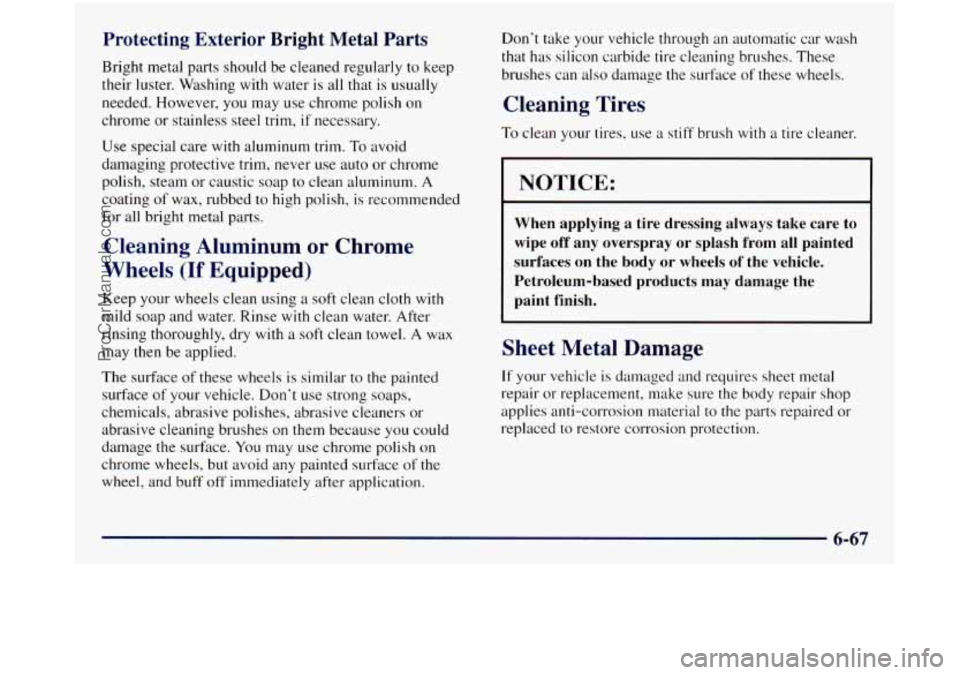
Protecting Exterior Bright Metal Parts
Bright metal parts should be cleaned regularly to keep
their luster. Washing with water is all that is usually
needed. However,
you may use chrome polish on
chrome or stainless steel trim, if necessary.
Use special care
with aluminum trim. To avoid
damaging protective trim, never use auto or chrome
polish, steam or caustic soap to clean aluminum.
A
coating of wax, rubbed to high polish, is recommended
for all bright metal parts.
Cleaning Aluminum or Chrome
Wheels (If Equipped)
Keep your wheels clean using a soft clean cloth with
mild soap and water. Rinse
with clean water. After
rinsing thoroughly, dry
with a soft clean towel. A wax
may then be applied.
The surface of these wheels is similar
to the painted
surface of your vehicle. Don’t use strong soaps,
chemicals, abrasive polishes, abrasive cleaners or abrasive cleaning brushes on them because you could
damage the surface.
You may use chrome polish on
chrome wheels, but avoid any painted surface of the
wheel, and buff off immediately after application. Don’t take your
vehicle through
an automatic car wash
that has silicon carbide tire cleaning brushes. These
brushes can also damage the surface of these wheels,
Cleaning Tires
To clean your tires, use a stiff brush with a tire cleaner.
I NOTICE:
When applying a tire dressing always take care to
wipe off any overspray or splash from all painted
surfaces on the body or wheels of‘the vehicle.
Petroleum-based products may damage the
paint finish.
Sheet Metal Damage
If your vehicle is damaged and requires sheet metal
repair or replacement, make sure the body repair shop
applies anti-corrosion material to the parts repaired or
replaced to restore corrosion protection.
6-67
ProCarManuals.com
Page 375 of 452
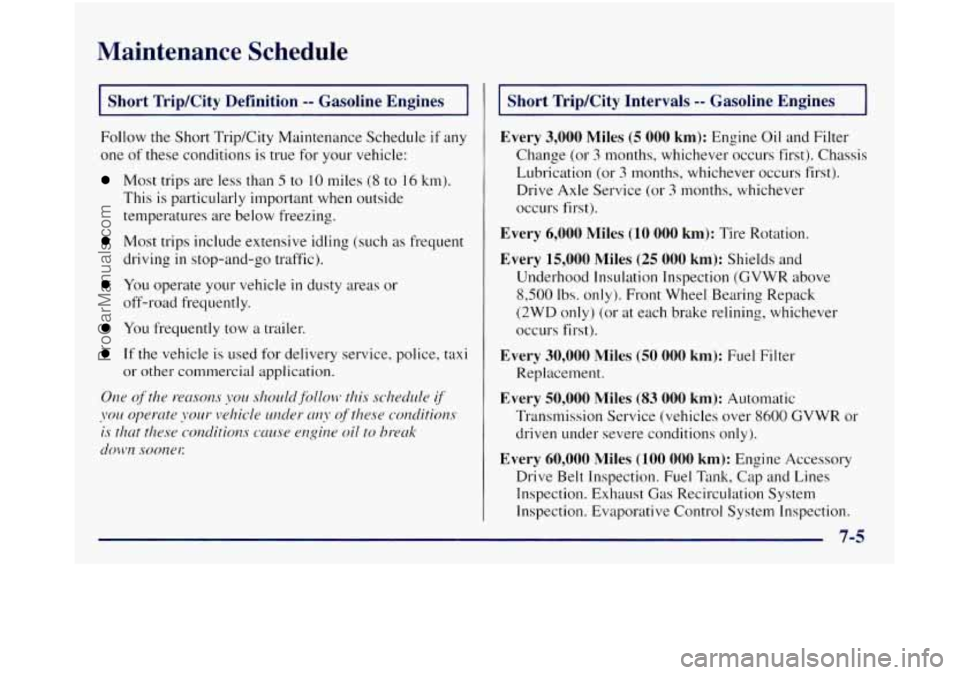
Maintenance Schedule
Short Trip/City Definition -- Gasoline Engines
Follow the Short Trip/City Maintenance Schedule if any
one of these conditions is true for your vehicle:
Most trips are less than 5 to 10 miles (8 to I6 km).
This is particularly important when outside
temperatures are below freezing.
Most trips include extensive idling (such as frequent
driving
in stop-and-go traffic).
You operate your vehicle in dusty areas or
off-road frequently.
You frequently tow a trailer.
If the vehicle is used for delivery service, police, taxi
or other commercial application.
One oj*tlw reclsorzs yo14 sl~or.~ld~foIlo~~~ this scI~edniv if
you operate yo1.w vehicle urlcler CIIZJ ojthese cor-zditions
is that these cwm1ition.s CCJLIS~ eqirw oil to break
dOC1!12 Sool-zel:
Short Trip/City Intervals -- Gasoline Engines
Every
3,000 Miles (5 000 km): Engine Oil and Filter
Change (or 3 months, whichever occurs first). Chassis
Lubrication (or 3 months, whichever occurs first).
Drive Axle Service (or 3 months, whichever
occurs first).
Every 6,000 Miles (10 000 km): Tire Rotation.
Every 15,000 Miles (25 000 km): Shields and
Underhood Insulation Inspection (GVWR above
8,500 lbs. only). Front Wheel Bearing Repack
(2WD only) (or at each brake relining, whichever
occurs first).
Every 30,000 Miles (50 000 km): Fuel Filter
Every 50,000 Miles (83 000 km): Automatic
Replacement.
Transmission Service (vehicles over
8600 GVWR or
driven under severe conditions only).
Every 60,000 Miles (100 000 km): Engine Accessory
Drive Belt Inspection. Fuel Tank, Cap and Lines
Inspection. Exhaust Gas Recirculation System
Inspection. Evaporative Control System Inspection.
ProCarManuals.com
Page 376 of 452

Maintenance Schedule
I Short Trip/City Intervals -- Gasoline Engines I
Every 100,000 Miles (166 000 km): Spark Plug Wire
Inspection. Spark
Plug Replacement. Automatic
Transmission Service (normal conditions). Positive
Crankcase Ventilation
(PCV) Valve Inspection.
Every 150,000 Miles (240 000 km): Cooling System
Service (or every
60 months, whichever occurs first). Follow this maintenance
schedule
only if none of the
conditions from the Short Trip/City Maintenance
Schedule is true.
Do not use this schedule if the vehicle
is used for trailer towing, driven in a dusty area or used
off paved roads. Use the Short Trip/City schedule for
these conditions.
Driving CI Ldzicle r+*ith CI fL1ly warmed engine urzder
highvvcry conditions
causes engine oil to break
dowm slorvcr.
7-6
ProCarManuals.com
Page 379 of 452

1 Short Trip/City Maintenance Schedule -- Gasoline Engines I
4:::: Drive axle service (see "Recommended Fluids and
Lubricants"
in the Index for proper lubricant to use):
0 Locking Differential -- Drain fluid and refill at first
engine oil change. At subsequent oil changes, check
fluid level and add fluid as needed.
If driving in
dusty areas or towing a trailer, drain fluid and refill
every
15,000 miles (25 000 km).
Standard Differential -- Check fluid level and add
fluid as needed at every oil change.
If driving in
dusty areas or towing a trailer. drain fluid and refill
every 15,000 miles (25
000 km).
More frequent lubrication may be required for
0 3500 HD Models with applications requiring
heavy-duty
or off-road use.
extreme overload/trailer towing conditions and
high-speed (above
45 mph or 70 km/h) conditions
for extended periods of time must have the drive axle
fluid changed every
30,000 miles (50 000 km).
See "Recommended Fluids and Lubricants" in
this section.
7-9
ProCarManuals.com
Page 387 of 452
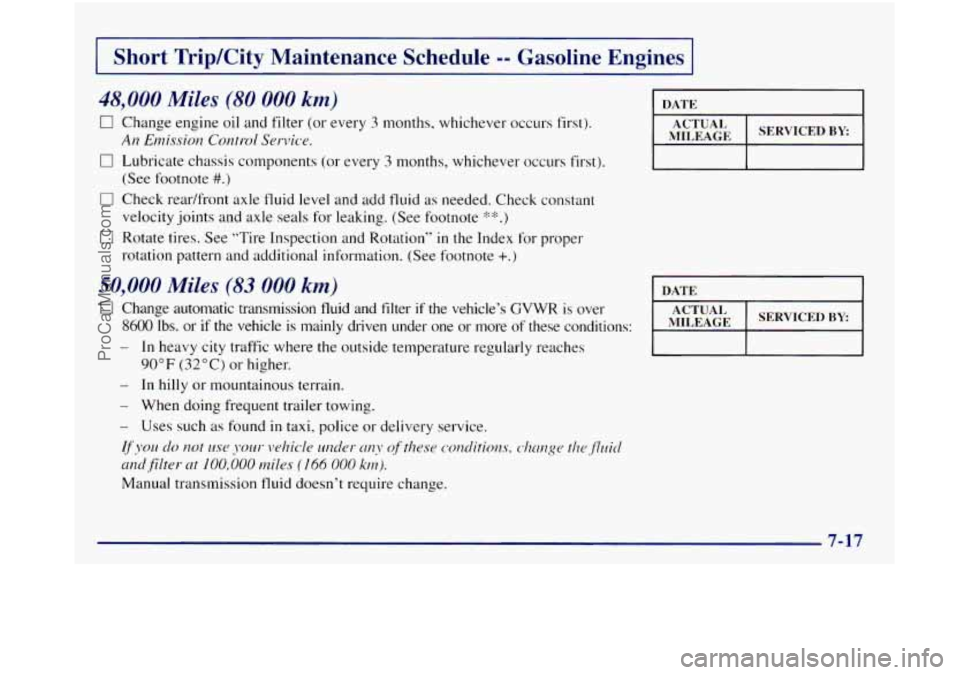
I Short TripKity Maintenance Schedule -- Gasoline Engines I
48,000 Miles (80 000 km)
0 Change engine oil and filter (or every 3 months, whichever occurs first).
0 Lubricate chassis components (or every 3 months, whichever occurs first).
0 Check readfront axle fluid level and add fluid as needed. Check constant
An Emission Control Service.
(See footnote #.)
velocity joints and axle seals for leaking. (See footnote *$:.)
0 Rotate tires. See “Tire Inspection and Rotation” in the Index for proper
rotation pattern and additional information. (See footnote
+.)
50,000 Miles (83 000 km)
DATE
I MILEAGE ACTUAL 1 SERVICEDBY I
DATE I
0 Change automatic transmission fluid and filter if the vehicle’s GVWR is over
MILEAGE
ACTUAL SERVICED BY 8600 lbs. or if the vehicle is mainly driven under one or more of these conditions:
- In heavy city traffic where the outside temperature regularly reaches
- In hilly or mountainous terrain.
- When doing frequent trailer towing.
- Uses such as found in taxi, police or delivery service.
IJ’pou do nut ~se your vehicle under NIIY of these cmditions, c.llcmge the.flLric1
und filter at IOO, 000 miles (I 66 000 kn;).
Manual transmission fluid doesn’t require change.
90°F (32°C) or higher.
7-17
ProCarManuals.com